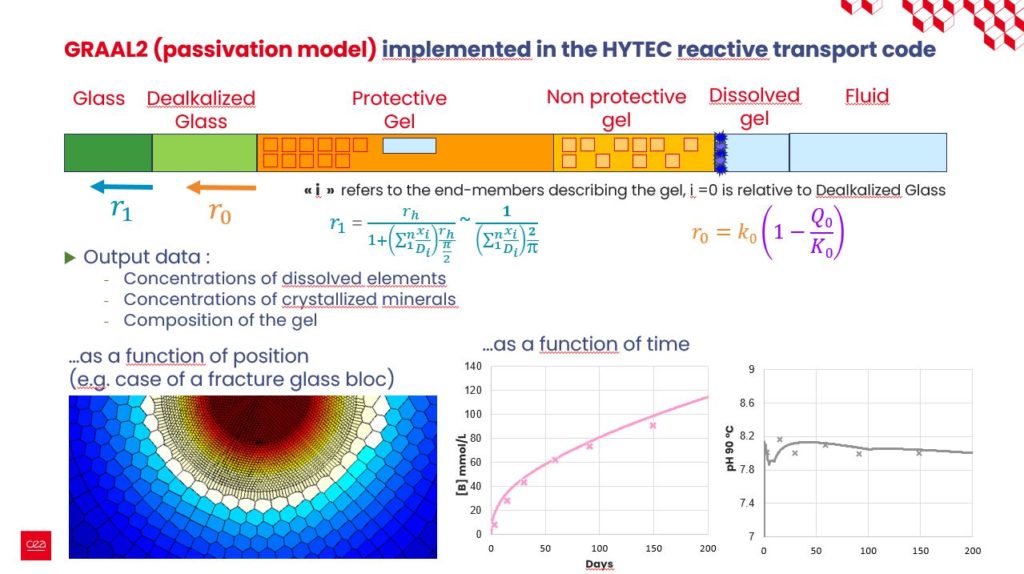Modeling the alteration of radioactive waste confinement glasses presents three main challenges:
i) Chemical complexity: The numerous major chemical elements in the glass, fluid, and environmental minerals interact with each other through fluid and gas.
ii) Temporal constraints: The goal is to predict confinement efficiency over several hundreds of thousands of years using data acquired over only a few months or years in the laboratory.
iii) Spatial constraints: This is demonstrated through key material transfers that occur both at the centimeter scale through diffusion/convection within the porous medium consisting of the fractured glass block and at the nanometer scale within the passivating gel on the surface of each glass piece.
To address the chemical complexity issue (i), thermodynamic databases like Thermochimie (Giffaut et al. (2014) that describe chemical reactions between elements can be used. Reactive transport codes can be applied to both laboratory experiments and waste packages in geological disposal, demonstrating the ability to use the same calculation tool for long-term predictions validated on laboratory experiments (ii). To address the spatial issue (iii), the GRAAL model can be used (Frugier et al. 2018), which allows for the implicit implementation of the passivation phenomenon in a reactive transport code that already contains the differential equations of diffusive-convective transport (Steefel et al. 2015). The GRAAL model can be run using the HYTEC reactive transport code (Van der Lee et al. 2003), as well as other similar codes: CRUNCH and PHREEQC.
Geochemical modeling occupies a central position in the multi-scale modeling of glass alteration. Probabilistic atomistic models allow the exploration of mechanisms at small scales, such as those related to the formation of passivating gel (Jan et al. 2019), while models further simplify mechanisms to facilitate scale changes, highlight predominant mechanisms, or improve communication and decision-making (Frugier et al. 2023).
Research directions of the ISEC/DPME related to the geochemical modeling of glass alteration include: (i) enriching the GRAAL model with a generalized passivation law and a more detailed chemical model to describe gel solubility to improve the model’s ability to take into account the chemical elements of the environment, resulting in the GRAAL2 model; (ii) conducting experiments on simple and complex glasses to parameterize and qualify the predictive capabilities of the GRAAL2 model; (iii) continuing experiments on the interaction between glass and environmental minerals to validate the model; and (iv) progressing with predictive simulations on complex systems at the glass package scale, such as taking into account the fracturing of the glass block (Repina 2019) and studying scale change strategies.
The hypotheses and equations of the GRAAL2 model are presented before providing examples of its application to experimental data (Figure 1).
Although geochemical modeling still relies on experimental measurements that provide essential thermodynamic and kinetic constants, it also uses technological innovations such as those implemented in geochemical codes (e.g. modeling of biphasic media by HYTEC), statistical calculation tools (e.g. URANIE uncertainty and sensitivity platform (Gaudier 2010)), and modern programming environments to manipulate large amounts of data and compare them with experimental data. Therefore, inferring the uncertainties in modeling parameters from experimental data and evaluating how these uncertainties impact the model’s predictions will aid in assessing the level of precision required to use geochemical models effectively.
REFERENCES
Frugier, P., N. Godon and Y. Minet (2023). Long-Term Performance Assessment of Nuclear Waste Glasses in a Geological Repository: a reactive diffusion model called “MOS”. Goldschmidt, Lyon, juillet 2023.
Frugier, P., Y. Minet, N. Rajmohan, N. Godon and S. Gin (2018). “Modeling glass corrosion with GRAAL.” npj Materials Degradation 2(1): 35.
Gaudier, F. (2010). “URANIE: The CEA/DEN Uncertainty and Sensitivity platform.” Procedia – Social and Behavioral Sciences 2(6): 7660-7661.
Giffaut, E., M. Grivé, P. Blanc, P. Vieillard, E. Colàs, H. Gailhanou, S. Gaboreau, N. Marty, B. Madé and L. Duro (2014). “Andra thermodynamic database for performance assessment: ThermoChimie.” Applied Geochemistry 49: 225-236.
Jan, A., J.-M. Delaye, S. Gin and S. Kerisit (2019). “Monte Carlo simulation of the corrosion of irradiated simplified nuclear waste glasses.” Journal of Non-Crystalline Solids 519: 119449.
Repina, M. (2019). Reactive transport modeling in fractured media of nuclear glass for industrial application, PSL Research University.
Steefel, C. I., C. A. J. Appelo, B. Arora, D. Kalbacher, O. Kolditz, V. Lagneau, P. C. Lichtner, K. U. Mayer, J. C. L. Meeussen, S. Molins, D. Moulton, D. Shao, J. Simunek, N. Spycher, S. B. Yabusaki and G. T. Yeh (2015). “Reactive transport codes for subsurface environmental simulation.” Computational Geosciences 19(3): 445-478.
Van der Lee, J., L. De Windt, V. Lagneau and P. Goblet (2003). “Module-oriented modeling of reactive transport with HYTEC.” Computers & Geosciences 29(3): 265-275.

